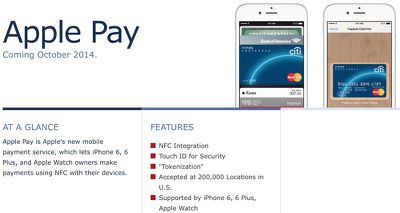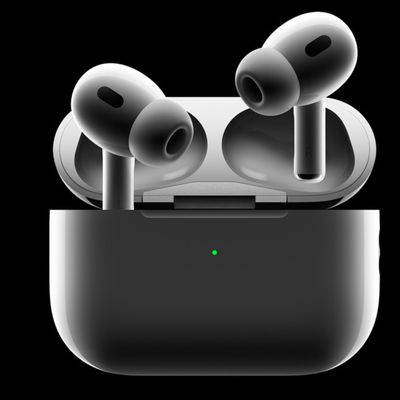Apple Pay Roundup: Everything We Know, Coming in October
Apple Pay is Apple's new mobile payments service, which it first debuted in September alongside the iPhone 6, the iPhone 6 Plus, and the Apple Watch. Apple Pay is expected to become widely available to consumers beginning in October, and ahead of its official release, we've gathered everything that's currently known about the service into a roundup so users can get an idea of what to expect.
With Apple Pay, iPhone 6 and 6 Plus owners will be able to make payments for goods and services with their iPhones, both in stores and within participating apps, using the NFC chip built into the devices. While Apple Pay will initially be restricted to iPhone 6 and 6 Plus owners, iPhone 5, 5c, and 5s users will also be able to take advantage of the service if they purchase an Apple Watch after it is released.

Apple has described Apple Pay as the most secure payment solution available, as it uses Device Account Numbers rather than storing credit card numbers and keeps all payment information in a dedicated chip on the iPhone, called the Secure Element.
All payments are verified using Touch ID, which prevents someone who has stolen a device to make unauthorized purchases. Furthermore, if an iPhone 6 or 6 Plus is stolen, its ability to make payments can be disabled through Find My iPhone.
Apple has said that Apple Pay will be available beginning in October, enabled through an upcoming update to iOS 8.
The Apple Pay roundup, like all of our other roundups is accessible through a dedicated index page that shows a full list of all available roundups ordered by most recent update. The roundup is also accessible directly through the "Roundups" tab in the top navigation bar on all MacRumors pages.
Popular Stories
The long wait for an Apple Watch Ultra 3 appears to be nearly over, and it is rumored to feature both satellite connectivity and 5G support.
Apple Watch Ultra's existing Night Mode
In his latest Power On newsletter, Bloomberg's Mark Gurman said that the Apple Watch Ultra 3 is on track to launch this year with "significant" new features, including satellite connectivity, which would let you...
The iPhone 17 Pro Max will feature the biggest ever battery in an iPhone, according to the Weibo leaker known as "Instant Digital."
In a new post, the leaker listed the battery capacities of the iPhone 11 Pro Max through to the iPhone 16 Pro Max, and added that the iPhone 17 Pro Max will feature a battery capacity of 5,000mAh:
iPhone 11 Pro Max: 3,969mAh
iPhone 12 Pro Max: 3,687mAh...
Apple's next-generation iPhone 17 Pro and iPhone 17 Pro Max are just over two months away, and there are plenty of rumors about the devices.
Below, we recap key changes rumored for the iPhone 17 Pro models.
Latest Rumors
These rumors surfaced in June and July:Apple logo repositioned: Apple's logo may have a lower position on the back of the iPhone 17 Pro models, compared to previous...
The upcoming iPhone 17 Pro and iPhone 17 Pro Max are rumored to have a slightly different MagSafe magnet layout compared to existing iPhone models, and a leaked photo has offered a closer look at the supposed new design.
The leaker Majin Bu today shared a photo of alleged MagSafe magnet arrays for third-party iPhone 17 Pro cases. On existing iPhone models with MagSafe, the magnets form a...
Apple's position as the dominant force in the global true wireless stereo (TWS) earbud market is expected to continue through 2025, according to Counterpoint Research.
The forecast outlines a 3% year-over-year increase in global TWS unit shipments for 2025, signaling a transition from rapid growth to a more mature phase for the category. While Apple is set to remain the leading brand by...
iOS 26 and iPadOS 26 add a smaller yet useful Wi-Fi feature to iPhones and iPads.
As spotted by Creative Strategies analyst Max Weinbach, sign-in details for captive Wi-Fi networks are now synced across iPhones and iPads running iOS 26 and iPadOS 26. For example, while Weinbach was staying at a Hilton hotel, his iPhone prompted him to fill in Wi-Fi details from his iPad that was already...
Apple today seeded the second betas of upcoming iOS 18.6 and iPadOS 18.6 updates to public beta testers, with the betas coming just a day after Apple provided the betas to developers. Apple has also released a second beta of macOS Sequoia 15.6.
Testers who have signed up for beta updates through Apple's beta site can download iOS 18.6 and iPadOS 18.6 from the Settings app on a compatible...




















